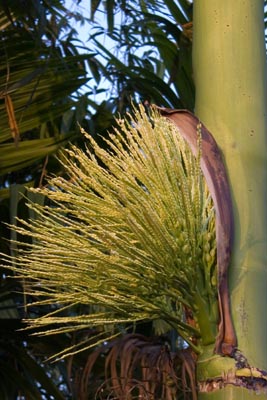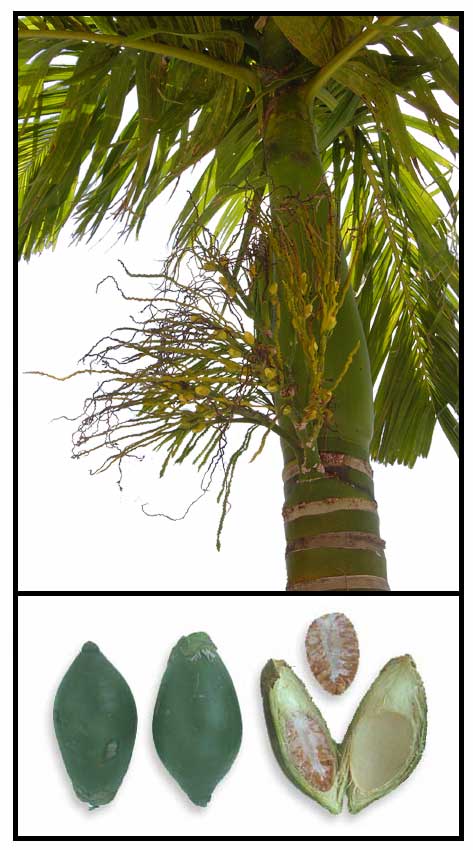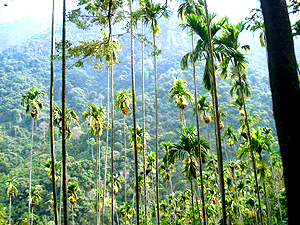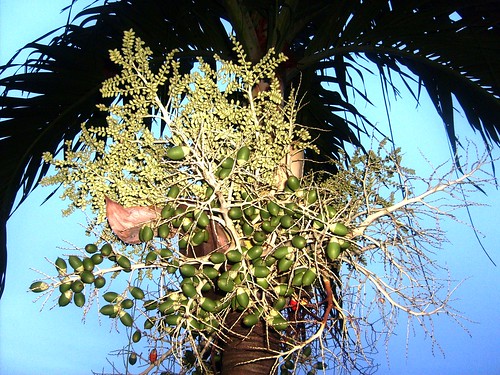Areca is a genus of about 50 species of single-stemmed palms in the family Arecaceae, found in humid tropical forests from Malaysia to the Solomon Islands.
The best-known member of the genus is A. catechu, the areca nut palm. Several species of Areca nuts, known for their bitter and tangy taste, are routinely used for chewing, especially in combination with the leaves of Betel, tobacco and Calcium hydroxide (lime). This practice is popular among elderly people in southeastern Asia, and it is allegedly one of the causes of oral cancer in the region.
The areca nut tree belongs to the same family as the oil palm and talipot palm, but straight and slender, its appearanc is quite different.
Species
- Areca abdulrahmanii J.Dransf. (1980).
- Areca ahmadii J.Dransf. (1984).
- Areca andersonii J.Dransf. (1984).
- Areca arundinacea Becc. (1877).
- Areca brachypoda J.Dransf. (1984).
- Areca caliso Becc. (1919).
- Areca camarinensis Becc. (1919).
- Areca catechu L. (1753) : Betel Palm
- Areca celebica Burret (1933).
- Areca chaiana J.Dransf. (1984).
- Areca concinna Thwaites (1864).
- Areca congesta Becc. (1923).
- Areca costulata Becc. (1919).
- Areca dayung J.Dransf. (1980).
- Areca furcata Becc. (1877).
- Areca glandiformis Lam. (1783).
- Areca guppyana Becc. (1914).
- Areca hutchinsoniana Becc. (1919).
- Areca insignis (Becc.) J.Dransf. (1984).
- Areca insignis var. insignis
- Areca insignis var. moorei (J.Dransf.) J.Dransf. (1984)
- Areca ipot Becc. (1909).
- Areca jobiensis Becc. (1877).
- Areca jugahpunya J.Dransf. (1984).
- Areca kinabaluensis Furtado (1933).
- Areca klingkangensis J.Dransf. (1984).
- Areca laosensis Becc. (1910).
- Areca ledermanniana Becc. (1923).
- Areca macrocalyx Zipp. ex Blume (1839).
- Areca macrocarpa Becc. (1909).
- Areca minuta Scheff., (1876).
- Areca montana Ridl., (1907).
- Areca multifida Burret (1936).
- Areca nannospadix Burret (1931).
- Areca nigasolu Becc. (1914).
- Areca novohibernica (Lauterb.) Becc. (1914).
- Areca oxycarpa Miq. (1868).
- Areca parens Becc. (1919).
- Areca rechingeriana Becc. (1910).
- Areca rheophytica J.Dransf. (1984).
- Areca ridleyana Becc. ex Furtado (1933).
- Areca rostrata Burret (1935).
- Areca salomonensis Burret (1936).
- Areca subacaulis (Becc.) J.Dransf. (1984).
- Areca torulo Becc. (1914).
- Areca triandra Roxb. ex Buch.-Ham. (1826).
- Areca tunku J.Dransf. & C.K.Lim (1992).
- Areca vestiaria Giseke (1792).
- Areca vidaliana Becc. (1907).
- Areca warburgiana Becc. (1914).
- Areca whitfordii Becc. (1907).
The Areca nut is the seed of the Areca palm (Areca catechu), a straight and graceful palm tree growing in most tropical countries.
The areca nut is not a true nut but rather a drupe. It is commercially available in dried, cured and fresh forms. While fresh, the husk is green and the nut inside is so soft that it can easily be cut with an average knife. In the ripe fruit the husk becomes yellow or orange and, as it dries, the fruit inside hardens to a wood-like consistency. At that stage the areca nut can only be sliced using a special scissor-like cutter (known as Sarota in Hindi and Aḍakattera in Telugu).
Usually a few slices of the nut are wrapped in a Betel leaf along with lime and may include clove, cardamom, catechu (kattha), etc. for extra flavouring. Betel leaf has a fresh, peppery taste, but it can be bitter depending on the variety.
Areca nuts are chewed with betel leaf for their effects as a mild stimulant, causing a hot sensation in the body, heightened alertness and sweating, although the effects vary from person to person. The areca nut contains tannin, gallic acid, a fixed oil gum, a little terpineol, lignin, various saline substances and three main alkaloids: Arecoline, Arecain and Guracine which have vasocontricting properties. The betel leaf chewed along with it contains eugenol, also a vasoconstrictor. Many chewers also add small pieces of tobacco leaf to the mixture, thereby adding the effect of the nicotine, which causes greater addiction than the drugs contained in the nut and the betel. At any rate, the effect of chewing betel and nut is relatively mild and it could be compared to drinking a strong cup of coffee.
In East and North-East India areca nuts are not only chewed along with betel leaf but are also used in the preparation of Ayurvedic medicines. Powdered areca nut is used as a constituent in some tooth powders. Other medicinal uses include the removal of tapeworms and other intestinal parasites by swallowing a few teaspoons of powdered areca nut, or by taking tablets containing the extracted alkaloids.
he term "Betel nut" and the colonial legacy
In English, the areca nut is also widely known as Betel nut (or "Betelnut"), because it is mostly chewed along with Betel, the leaf of a vine belonging to the Piperaceae family. The term "Betel nut" is technically incorrect, for the betel vine produces no nuts, and this inaccurate term creates quite a bit of confusion regarding the discernment between the nut and the leaf.
The muddling between the areca nut and the betel leaf, by calling the nut "betel nut", is restricted to the languages of the colonizing powers, like English, French, Dutch, Portuguese and German, a lack of accuracy that is likely a legacy of the colonial contempt for "the natives" chewing the mixture. In the languages of the places where the Areca nut is traditionally chewed there is a clear and separate term for the areca nut and another for the betel leaf. This clear distinction is important in societies where both the areca nut and the betel leaf have a ceremonial and even sacred value. Furthermore, there is commonly a specific verb for the activity of chewing both of them together.


There was a certain amount of prejudice among the European colonial powers against the tradition of chewing of Areca nut and betel. Unlike the quick adoption of tobacco by Europeans in the American colonies, chewing areca nut and betel was an addictive habit not adopted by the colonizers of South and Southeast Asia. Officers freshly posted in the East India or Indochina colonies, whether British, French or Dutch, regarded the red-stained mouths of pan-chewers with dread, as something too foreign and weird for them. This abhorrence is not only evident in the writings of authors of the Victorian era, but in more recent writers like George Orwell, Somerset Maugham and V.S. Naipaul. Often this spirit expresses itself in mockery and ridicule, like in the Broadway musical South Pacific (musical) tune "Bloody Mary," with the line "Bloody Mary's chewing betel nuts... and she don't use Pepsodent."


Tradition

Chewing the mixture of areca nut and betel leaf is a tradition, custom or ritual which dates back thousands of years from South Asia to the Pacific. It constitutes an important and popular cultural activity in many Asian and Oceanic countries, including Myanmar, Cambodia, the Solomon Islands, Thailand, Laos, and Vietnam. It is not known how and when the areca nut and the betel leaf were married together as one drug. Archaeological evidence from Thailand, Indonesia and the Philippines suggests that they have been used in tandem for four thousand years or more.



In Vietnam the areca nut and the betel leaf are such important symbols of love and marriage that in Vietnamese the phrase "matters of betel and areca" (chuyện trầu cau) is synonymous with marriage. Areca nut chewing starts the talk between the groom's parents and the bride's parents about the young couple's marriage. Therefore the leaves and juices are used ceremonially in Vietnamese weddings. The folk tale explaining the origin of this Vietnamese tradition is a good illustration of the fact that the combination of areca nut and the betel leaf is ideal to the point that they are practically inseparable, like an idealized married couple.
Malay culture and tradition hold betel nut and leaves in high esteem. Traditionally, guests who visits a malay house are given a tray of betel nuts and betel leaves, the same way as one offering drinks to a guests now. There's even a malay proverb about the betel nut, "bagaikan pinang dibelah dua", loosely translated, like a betelnut divided in half. It usually refers to newlyweds, who are compatible to each other, just like a betel nut when divided in half.

In the Indian Subcontinent the chewing of betel and areca nut dates back to the pre-Vedic Harappan empire. Formerly in India and Sri Lanka it was a custom of the royalty to chew Areca nut and betel leaf. Kings had special attendants carrying a box with the ingredients for a good chewing session. There was also a custom to chew Areca nut and betel leaf among lovers because of its breath-freshening and relaxant properties. Hence there was a sexual symbolism attached to the chewing of the nut and the leaf. The areca nut represented the male and the betel leaf the female principle. Considered an auspicious ingredient in Hinduism, the Areca nut is still used along with betel leaf in religious ceremonies and also while honoring individuals in most of Southern Asia.
In Assam it is a tradition to offer Pan-tamul (Betel leaves and raw areca nut) to guests after tea or meals in a brass plate with stands called a Bota. Among the Assamese the areca nut also has a variety of uses during religious and marriage ceremonies, where it has the role of a fertility symbol. A tradition from Upper Assam is to invite guests to wedding receptions by offering a few areca nuts with betel leaves. During Bihu, the husori players are offered areca nuts and betel leaves by each household while their blessings are solicited.
Spanish mariner Álvaro de Mendaña reported how the Solomon Islanders were chewing the nut and the leaf with caustic lime that stained their mouths red. He noticed that friendly and genial chief Malope in Santa Isabel Island was offering him the stuff as a token of friendship every time they met.
The adding of tobacco leaf (the most harmful and addictive component) to the chewing mixture is a relatively recent introduction, for tobacco was introduced from the American Continent in colonial times, a mere few centuries compared to the millenia that the tradition exists in South and Southeast Asia.
Vernacular names
- Sanskrit: Puga or Pugaphala.
- Are Are: Ota.
- Assamese: Guwa or Tamol .
- Bengali: Chalia/Supari.
- Burmese: Kunya.
- Chamorro: Pugua (areca nut), papulu (betel), åfok (lime), måmå'on (the chewing or the preparation).
- Divehi: Fōh or Fuvah (areca nut), bileiy (betel)
- Hindi, Urdu, Marathi,: Supari.
- Guadalcanal: Bua.
- Javanese: Jambe.
- Khasi: Kwai.
- Kannada: Adike
- Khmer:
- Lao:
- Malay: Pinang
- Malayalam: Adakka
- Mon: Sōd.
- Nanggu: Kertu (areca nut), pwe (betel), ndo (lime).
- Raga (North Pentecost): Niniu.
- Sinhala: Puwak
- Tagalog: Tempak Siri or Nga Nga.
- Taiwan: Bīnláng.
- Tamil: Paakku
- Telugu: Pooka
- Tetum: Bua (areca nut), malus (betel), ahu (lime), mama (the chewing or the preparation).
- Thai: Mahk (areca nut), plue (betel).
- Tokodede: Buo (areca nut), malu (betel), rapo (lime), mam (the chewing or the preparation).
- Vietnamese: Cau.
Places like Guwahati in Assam , Penang in Malaysia and Fua Mulaku in Maldives have been named after the areca nut.
Modern day consumption
In India (the largest consumer of areca nut) and Pakistan the preparation of nut with or without betel leaf is commonly referred to as paan. It is available practically everywhere and is sold in ready-to-chew pouches called "Pan Masala" or supari, as a mixture of many flavors whose primary base is areca nut crushed into small pieces. Pan Masala with a small quantity of tobacco is called gutka. The easily-discarded small plastic supari or gutka pouches are an ubiquitous pollutant of the South Asian environment. Some of the liquid in the mouth is usually disposed of by spitting, producing bright red spots which are highly visible in the streets. Trails of those red stains lining the sidewalks in India and Sri Lanka are a sure indication of the popularity of betel chewing in an area. The Shimoga District in Karnataka is presently the largest producer of betelnut in India.
In the Maldives areca nut chewing is very popular, but spitting is frowned upon and regarded as an unrefined, gross way of chewing. Usually people prefer to chew thin slices of the dry nut, which is sometimes roasted. "Kili", a mixture of areca nut, betel, cloves, cardamom and sugar is sold in small home-made paper pouches. Old people who have lost their teeth keep "chewing" by pounding the mixture of areca nut and betel with a small mortar and pestle.
In Papua New Guinea and the Solomon Islands, fresh areca nut, betel leaf or 'fruit leaf' ("daka" in PNG) and lime are sold on street corners. In these countries, dried or flavoured areca nut is not popular. Areca nut chewing has recently been introduced into Vanuatu where it is growing in popularity, especially in the northern islands of the country. In Guam, betel and areca nut chewing is a social pastime as a means to extend friendship, and can be found in many, if not most, large gatherings as part of the food display.
In Taiwan, bags of 20 to 40 areca nuts are purchased fresh daily by a large number of consumers. To meet the steady year-round demand, there exist two kinds of betel-nut shops, each of which sells cigarettes and drinks including beer in addition to their primary purpose of supplying betel and nuts. On one hand, there are small mom and pop shops that are often poorly maintained and often do not stand out from other stores nearby. On the other hand, the second provides a sight unique to Taiwan. Such a shop often consists of nothing more than a single free-standing room, or booth, elevated one meter above the street that measures less than 3 meters by 2 meters. Large picture windows comprise two or more of the walls, allowing those who pass by a complete view of the interior. The interior is often painted brightly. Within such a shop, a sexily dressed young woman can be seen preparing betel and areca nuts (see "Betel nut beauty"). Shops are often identified by multicolored (commonly green) fluorescent tubes or neon lights that frame the windows or that are arranged radially above a store. Customers stop on the side of the road and wait for the girls to bring their betel and areca nut to their vehicles.
In Thailand the consumption of areca nut has declined gradually in the last decades. The younger generation rarely chews the substance, especially in the cities. Most of the present-day consumption is confined to older generations, that is mostly people above fifty. Even so, small trays of betel leves and sliced tender arecanut are sold in markets and used as offerings in Buddhist shrines.
In the Philippines, chewing the areca nut and betel leaf was a very important tradition in the past. Nowadays this tradition is almost dead among the urban people in the cities and big towns who consider that it is against the general trend of being westernized. Except in some small towns, chewing betel has largely been replaced by chewing gum and cigarettes.
In the United States, areca nut is not a controlled or specially taxed substance and may be found in some Asian grocery stores. However, importation of areca nut in a form other than whole or carved kernels of nuts can be stopped at the discretion of US Customs officers on the grounds of food, agricultural, or medicinal drug violations. Such actions by Customs are very rare. In the United Kingdom areca nut is readily available in Asian grocery stores and even in shredded forms from the World Food aisles of larger Tesco supermarkets.
Effects on health
The International Agency for Research on Cancer (IARC) regards the chewing of betel and areca nut to be a known human carcinogen. Certain studies have sought to prove that regular chewers of betel leaf and areca nut have a higher risk of damaging their gums and acquiring cancer of the mouth and of the stomach, identifying the tobacco and the caustic lime as prime factors in the increased risk.
Very few studies exist of the use of a "pure" paan preparation: areca nut, betel leaf, and lime, and fewer studies exist of the areca nut alone. A certain research reached the conclusion that unprocessed areca nuts, at high doses, displayed a very weak carcinogenicity. The International Agency for Research on Cancer (IARC) reached the conclusion that there is sufficient evidence that the habit of chewing betel quid containing tobacco is carcinogenic to humans, but that there is inadequate evidence that the same habit is carcinogenic to humans when no tobacco is added.
According to Medline Plus, "Long-term use has been associated with oral submucous fibrosis (OSF), pre-cancerous oral lesions and squamous cell carcinoma. Acute effects of betel chewing include asthma exacerbation, hypertension, and tachycardia. There may be a higher risk of cancers of the liver, mouth, esophagus, stomach, prostate, cervix, and lung with regular betel use. Other effects can include a possible effect on blood sugar levels, possibly increasing the risk of type 2 diabetes.
Regular betel chewing causes the teeth and gums to be stained orange/red, a color that was formerly considered attractive in certain cultures. In Telugu poetry the slightly red-stained lips of a young woman chewing areca nut and betel are considered a mark of beauty. It is believed that regular chewing reduce the incidence of cavities, and toothpastes were once produced containing betel extracts. However, the increase in mouth ulcers and gum deterioration caused by areca nut and betel chewing may outweigh any positive effects.
According to traditional Ayurvedic medicine chewing areca nut and betel leaf is a good remedy against bad breath (halitosis). MedlinePlus indicates "poor-quality research" showing a possible beneficial effect for sufferers of anaemia during pregnancy. However, it counsels against areca nut chewing due to a possible risk of spontaneous abortions. It also indicates "poor-quality studies" showing a possible beneficial effect on schizophrenia and for stroke recovery. Some people claim that chewing Areca nuts with betel increases the capacity to work.










1 comment:
Betel nut suppliers
Post a Comment